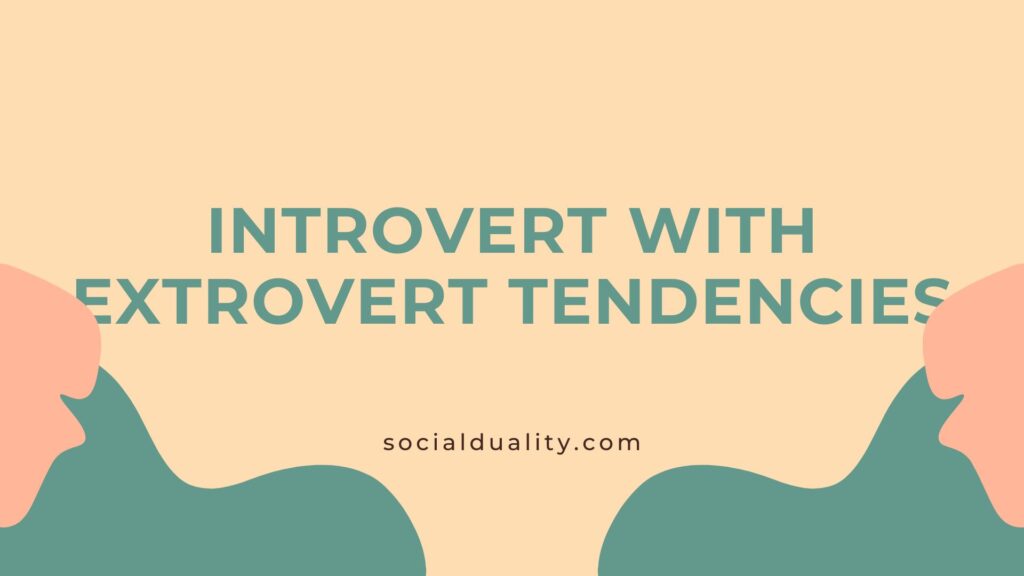Imagine being caught in the crossfire of social preferences, like a pendulum swinging between enjoying your own company and craving social interactions. Welcome to the world of ambiverts, the introverts with extroverted tendencies. The term ‘ambivert’ encapsulates those who strike a balance between the solitary introspection of an introvert and the social butterfly nature of an extrovert.
This fluctuating social energy can sometimes feel like a rollercoaster, but it’s these very tendencies that make ambiverts so adaptable and versatile. In this post, we’ll delve into the key signs of an ambivert, their unique social dynamics, and how online therapy can help them maintain their mental health. So, if you often feel like you’re walking a tightrope between introversion and extroversion, you might just find some solace here.
Key Takeaways
- Ambiverts display a unique combination of extroverted and introverted behaviors.
- They can thrive in both group and individual settings, and have the capacity to adapt their social behavior based on the situation.
- Their fluctuating social energy may impact their mental health, making it important for them to understand and balance their social needs.
- Online therapy can be a beneficial tool for ambiverts, helping them navigate their unique social dynamics and mental health needs.
- Ambiverts’ balanced traits make them effective leaders, able to connect with a wide range of people and adjust their behavior as needed.


5 Key Signs of an Introvert with Extroverted Tendencies
Diving into the five distinct indicators of an introvert who exhibits extroverted tendencies, it’s clear that a unique blend of qualities marks this personality type. This includes balanced social interactions; the person can function in solitude yet also in group settings without experiencing discomfort. Another sign is fluctuating social energy, where they can enjoy socializing, but also need time alone to recharge.
They are also comfortable with small talk and deep conversations, able to engage in light, casual discussions while simultaneously craving deeper, more substantial connections. A flexible social preference is another trait, as they can adjust their social behavior according to the situation or their emotional state. Lastly, varied perceptions by others, who may view them as sociable or reserved, further signify their balanced personality traits.
These traits clearly depict a person who is neither exclusively an introvert nor an extrovert, but rather a balanced blend of both, embodying the term ‘ambivert’. This personality type can navigate the ever-changing dynamics of social interactions with relative ease, adjusting their behavior to match the situation. By understanding their tendencies, ambiverts can ensure optimal mental health and personal fulfillment.
Why Ambiverts Tend to Excel in Group and Individual Projects
The inherent flexibility of ambiverts makes them uniquely positioned to excel in both solo and team-based tasks. Their tendencies allow them to adapt to various situations, whether it requires individual focus or collaborative effort. Our insights on introvert-extrovert dynamics at work dive further into how this adaptability plays out in professional contexts.
Notably, the versatility of ambiverts is not confined to their work habits. It extends to their social interactions, wherein they can engage in both small talk and deep discussions, relating to a wide spectrum of individuals. This ability to navigate various social scenarios aids them in establishing meaningful relationships, while also ensuring their personal needs for solitude are met.
In essence, the unique traits of ambiverts, which fluctuate between introversion and extroversion, equip them with the flexibility to thrive in diverse settings. This adaptability, coupled with an understanding of their own social energy, makes them particularly effective in both group and individual projects.


The Unpredictable Fluctuation of an Ambivert’s Need for Alone Time
Diversions in the social energy of ambiverts are quite unpredictable, with periods of intense social interaction often balanced by equally necessary solitary phases. These fluctuations are not random but rather tied to their ambivert tendencies. It is common for ambiverts to bask in the company of others, engaging in lively conversation and activities. Yet, the same individuals also cherish their alone time, using it to recharge and balance their mental energy. It’s a dance of extroversion and introversion, a see-saw of social engagement and solitude. These oscillations in energy levels and social preference are not indicative of inconsistency, but rather a reflection of their unique personality trait. In our blog post on introverts and extroverts in relationships, we delve deeper into how these dynamics play out.
The Impact of Extroverted Tendencies on Mental Health
Investigating the effects of extroverted behavior on one’s psychological well-being reveals intriguing insights. Ambiverts, those exhibiting both introverted and extroverted tendencies, may experience unique mental health outcomes. Their ability to adapt to various social scenarios ensures they’re comfortable in diverse situations. However, these fluctuations between high social engagement and solitude could potentially lead to emotional exhaustion if not managed effectively. This study provides an in-depth exploration of this phenomenon. While an extroverted disposition can foster positive connections and increase opportunities, it’s vital that ambiverts balance their social energy to avoid burnout. Recognizing their tendencies and implementing strategies to maintain equilibrium plays a critical role in their overall mental health. Therefore, ambiverts should strive to understand their unique social dynamics, ensuring they can enjoy the benefits of extroversion without compromising their psychological well-being.
How Online Therapy Can Support Introverts with Extroverted Streaks
Online therapeutic support can be particularly beneficial for individuals identified as ambiverts, who exhibit both introverted and extroverted tendencies. For those of us who find ourselves comfortably shifting between social engagement and solitude, understanding and managing these fluctuations is critical. Through online therapy, ambiverts can gain insights into their social behavior, learn effective strategies to balance social energy, and avoid potential emotional exhaustion. Especially for those who may encounter challenges in maintaining this balance, online therapy provides a safe and convenient platform to explore and address these issues. In our discussion on the science behind introversion and extroversion, we delve deeper into understanding these unique personality traits. Embracing online therapy can help ambiverts to flourish in their social interactions, while also respecting their need for personal downtime.
The Social Dynamics of an Extroverted Introvert
Navigating the intriguing behavior of an individual with both introverted and extroverted tendencies reveals an adaptable and flexible personality. The fluctuating social energy of ambiverts allows them to fit comfortably in various settings, from engaging group activities to reflective solitude. Their social interactions maintain a unique balance, as they are drawn to both lively chatter and introspective conversations.
An ambivert’s social preferences highlight their ability to connect on different levels, making them versatile in diverse situations. As they oscillate between sociability and reserve, their perceptions by others vary, reflecting their dynamic personality traits. They excel in individual and group projects, and their engaging nature coupled with their need for downtime often leads to a balanced mental state.
Understanding these social dynamics and the impact they have on mental health can help ambiverts maintain a healthy balance. Our discussion on introverts versus extroverts psychology further explores these fascinating social dynamics.
Why Ambiverts Enjoy Small Talk Yet Crave Deep Connections
Diving deeper into the ambivert psyche, we find that they exhibit tendencies to engage in chit-chat, yet also yearn for profound connections. This dual nature can be attributed to their ability to feel comfortable in diverse social situations. While their extroverted side enjoys the light-hearted banter, their introverted side simultaneously longs for meaningful connections. This unique balance allows them to partake in small talk, yet also have a desire for substantive, meaningful discussions.
Their dual tendencies allow them to interact freely in social settings, often leading to enriched conversations. However, they’ll often redirect these surface-level discussions towards more profound subjects, fulfilling their need for depth and connection.
For an intriguing read about ambiverts, you might want to check out Maureen Marzi Wilson’s book, ‘Introvert Doodles: An Illustrated Look at Introvert Life in an Extrovert World’, available on Amazon.
| Tendency | Enjoy Small Talk | Crave Deep Connections |
|---|---|---|
| Ambiverts | Yes | Yes |
| Introverts | No | Yes |
| Extroverts | Yes | No |
| Balanced Social Interactions | Yes | Yes |
| Fluctuating Social Energy | Yes | Yes |
Ambiverts: The Perfect Balance for Leadership Roles
Striking the right chord between introversion and extroversion, ambiverts demonstrate a harmonious blend of characteristics that are ideal for leadership roles. They can effortlessly tune their tendencies to suit diverse scenarios, making them adaptable leaders. The dual nature of ambiverts enables them to connect with people on various levels, enhancing their leadership potential.
Their social energy fluctuates, allowing them to participate actively in group interactions and also enjoy solitude. This flexibility ensures they are never overwhelmed by social situations or isolated for too long. Moreover, they are comfortable with both small talk and deep conversations, further broadening their social spectrum.
Travis Bradberry, a recognized expert on emotional intelligence, discusses the leadership potential of ambiverts in depth on his LinkedIn profile. By understanding their unique tendencies, ambiverts can leverage their strengths to excel in leadership roles and make meaningful contributions to their fields.
How Supporting Founders and CEOs Often Aligns with an Ambivert Personality
The balanced social energy of ambiverts tends to align well with the demands of supporting founders and CEOs. These leaders often require a delicate mix of solitude for decision-making and group engagement for successful team dynamics. Ambiverts, with their fluctuating social tendencies, can fluidly transition between these modes, making them invaluable assets to leadership figures.
An ambivert’s comfort with small talk can facilitate casual interactions with team members and stakeholders, fostering a friendly work atmosphere. Simultaneously, their craving for deep connections can enable them to forge meaningful relationships that underpin successful collaboration. In essence, ambiverts can bring a personable yet focused approach to their support roles.
Moreover, their varied perceptions can help them understand different perspectives within a team, further boosting their role as a bridge between leaders and team members. These attributes underscore the potential of an ambivert personality in supporting founders and CEOs.
Note: This content is intended for those already familiar with personality types and leadership support roles.


The Role of Stimulation in Ambiverts’ Lifestyle
Exploring the relationship between ambiverts and stimulation uncovers intriguing tendencies. Ambiverts, being neither completely introverted nor extroverted, often oscillate between seeking stimulating social interactions and craving quiet solitude. This behavior is influenced by fluctuating dopamine levels, a neurotransmitter linked to pleasure and reward.
Ambiverts’ social energy can significantly differ compared to introverts and extroverts. While they relish spending quality time with others, they equally value their alone time to recharge. This fluctuation can appear unpredictable to others, but for ambiverts, this flexible social preference is a common tendency.
Understanding this behavior can be beneficial. For example, a recent study on ResearchGate highlights the role of dopamine in shaping ambiverts’ social behaviors and mental health.
| Social Preference | Energy Fluctuation | Stimulation Need | Perception |
|---|---|---|---|
| Balanced | Fluctuating | Varied | Diverse |
| Introverted | Stable | Low | Reserved |
| Extroverted | Stable | High | Sociable |
Key to maintaining mental health for ambiverts is understanding and managing these tendencies.
Are Eating Disorders More Common in Ambiverts? Exploring the Link
Delving into the relationship between ambiverts and the prevalence of eating disorders, we find intriguing tendencies. Ambiverts, with their fluctuating social energy and flexible social preferences, face a unique set of mental health challenges. These individuals can be sociable one moment and crave solitude the next, implying a potential impact on their eating habits.
Certain studies suggest that ambiverts might be more prone to developing eating disorders due to their fluctuating need for stimulation and social interaction, although more research is needed in this area. This potential correlation offers a new perspective on understanding ambiverts’ mental health needs and how their particular personality traits may influence their relationship with food and body image. You can gain more insights into the topic through the writings of Travis Bradberry on LinkedIn, a renowned expert on emotional intelligence.
However, it’s essential to remember that an individual’s personality type doesn’t predetermine their health outcomes. Each person’s experience is unique and shaped by a myriad of factors beyond their personality type.
Conclusion
Understanding the unique balance of an ambivert personality can provide valuable insights into their social dynamics, mental health, and potential leadership capabilities. Navigating between solitude and socializing, they demonstrate a versatile approach to life, experiencing both the joy of connections and the peace of alone time. Their abilities to excel in various settings, connect on different levels, and adjust their behavior according to circumstances make them effective leaders and relatable individuals.
Yet, these fluctuations also emphasize the importance of mental health support for ambiverts. The potential impact on their well-being underscores the role of strategies like online therapy in maintaining balance. The exploration of possible links between ambiversion and eating disorders further highlights the need for ongoing research and understanding.
In essence, the journey of an ambivert, marked by their extroverted tendencies and introverted needs, reflects the fascinating intricacy of human nature. As we continue to explore and understand these dynamics, we also learn more about ourselves and the diverse world around us. As the saying goes, variety is indeed the spice of life.
FAQ
1. What are the signs of an introvert with extroverted tendencies?
The signs of an introvert with extroverted tendencies, or an ambivert, include balanced social interactions, fluctuating social energy, comfort with both small talk and deep conversations, flexible social preferences, and varied perceptions by others. Some people might view them as outgoing, while others see them as reserved, which reflects their ability to balance both introverted and extroverted traits.
2. How do ambiverts perform in group and individual projects?
Ambiverts excel in both group and individual projects due to their ability to adapt to various situations. They can work independently, drawing from their introverted side, and also appreciate team input, tapping into their extroverted tendencies. This flexibility makes them versatile and often highly effective in diverse work environments.
3. How do extroverted tendencies impact an ambivert’s mental health?
The ability of ambiverts to switch between introverted and extroverted behaviors can have significant impacts on their mental health. There can be periods of stress or burnout if they don’t adequately balance their need for social interaction with restorative alone time. It’s essential for ambiverts to recognize their fluctuating needs and seek help when necessary, such as through online therapy, which can be a flexible and accessible support method.
4. What are the social dynamics of extroverted introverts?
As extroverted introverts, ambiverts are quite skilled at navigating social settings. Their adaptable nature allows them to enjoy social interactions, yet they also value and require personal space to recharge. They can connect with a wide range of people, participate in various social activities, yet also appreciate their solitude.
5. Is there a link between ambiversion and eating disorders?
The potential link between ambiversion and eating disorders is an area of exploration. Like with any personality type, the unique traits and tendencies of ambiverts, such as a fluctuating need for stimulation and social interaction, could impact their mental and physical health. Any concerns about health and wellbeing should always be addressed with a health professional.


